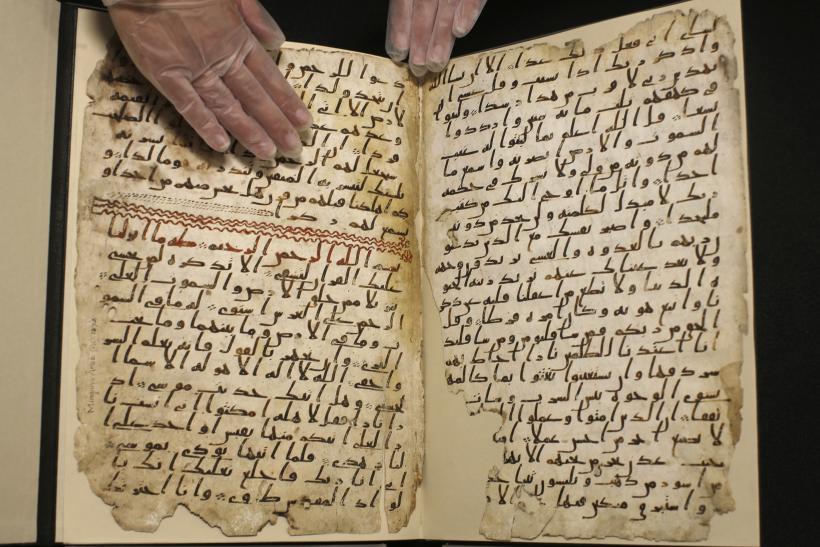Views: From Scriptural Text to Quranic Discourses, a Reading of the Discourse of Nasr Abu Zayd

The intellectual and cultural stagnation in our lives makes thinking seem more like running in place. It leads us to embalm our thinkers the better to study them, thus obscuring their fluidity of thought and intellectual shifts, and the evolution of their thought resulting from the interplay of thought and reality. An exemplary case is our study of the discourse of Nasr Hamed Abu Zayd. Fixing him in the era of his The Concept of the Text, where Arabic ‘academic’ study has imprisoned it, blinds us to Abu Zayd’s intellectual evolution: his shift from thinking of the Quran as a text and a book to conceiving it as a discourse, or set of discourses, and how this may influence hermeneutics and contemporary religious awareness. This essay will therefore attempt to spotlight the development of Abu Zayd’s thought and his engagement with reality and other diverse discourses.
Nasr Abu Zayd (1943–2010) attended university in the wake of the Arab states’ defeat in the 1967 Arab-Israeli war; an era in which the meaning of religion was transformed—once ‘people are equal like the teeth of a comb,’ it became ‘we have raised some of them above others in rank’—as the ship of state tacked away from social justice toward economic liberalization in the late 1960s and 70s.
Abu Zayd examined the methods of the classical speculative theologians (mutakallimun) and their approach to the Quran in his study of the Mutazilite understanding of figurative language in their disputes with the Ashaarites. He followed this up with a study of Sufism and its mystic engagement with scripture in The Philosophy of Hermeneutics: A Study of Ibn al-Arabi’s Hermeneutics of the Quran. Through this, Abu Zayd learned that a utilitarian approach that used texts to justify reality, something he had experienced in his own time, was an extension of practices from the classical era, when political, social, and cultural conflicts were channelled into factional conflicts over texts.
For Abu Zayd, the question was whether it is possible to discern an objective meaning of the text independent of prior ideological assumptions and biases. In other words, is it possible for us to determine a true or correct meaning of the text? He began studying the Quranic sciences in their later form as articulated by al-Zarkashi and al-Suyuti, with an eye to seeing if classical scholars had an understanding or conception of the text as the term is used in modern linguistics and textual analysis.
In his The Concept of the Text, Abu Zayd approached Quranic studies using modern textual analysis as well as linguistics and rhetoric as practiced by classical Muslim scholars, such as the Mutazilites and Abd al-Qahir al-Jurjani, and modern scholars like Mohammad Abduh and Amin al-Kholi. The study was predicated on Mutazilite theology and its concept of the created Quran and its historicity, as opposed to Ashaarite and classical Salafi theology, which views the Quran as eternal and uncreated, existing outside of time and place. In the work, Abu Zayd defended a correct, clear understanding based on reason and proof, as against deceptive understandings inimical to reason and argument.
From the late 1980s to the mid-1990s, Abu Zayd shifted his attention from a critical engagement with classical scholars to grapple directly with contemporary religion, its media message, and the discourse about religion and tradition. Amid the furore of being denied promotion to full professor and the lawsuit filed seeking to forcibly divorce him from his wife, Abu Zayd engaged in a process of self-criticism. He realized that in responding to the interpretations of his opponents, he relied on dialectical argument or disputation; even if he reached different conclusions, both interpretations were nevertheless based on shared assumptions. Though his interpretations may be more rational, humane, or inclusive, they were nevertheless based on the principle of thesis/antithesis.
Abu Zayd turned this critical eye to his previous studies and his view of the Mutazilites, critiquing their understanding of reason and their limited conceptions of freedom, noting that their own concepts were circumscribed by the age in which they lived, the limits of their historical experience, and its epistemic ceiling. He also critiqued his study of Ibn Arabi, and how he had stopped at what Ibn Arabi said rather than how he said it or what he did not say. He critiqued the method of his professor, Hassan Hanafi, as ‘contrived’: by forcing new meanings into same old theological bottles, Hanafi was simply putting a new coat of paint on an old house rather than rebuilding the sciences of the classical scholars.
Abu Zayd concluded that in striving for a clear, rational meaning of scripture, he had based his hermeneutics on the same theological axioms as his opponents. Although this hermeneutics led to results that were the antithesis of the traditional discourse, ultimately it further cemented these same axioms. For example, when arguments citing texts are responded to with an argument citing other texts, the second argument may end up offering an alternate reading of the text, but the method itself—employed by both disputants—only affirms the authority of the text, underscoring the rule that for any act or opinion to be legitimate, it must be backed by a text.
Abu Zayd expounded on this point in his study of how Abu Hamid al-Ghazali’s discourse culturally marginalized that of Ibn Rushd. Although Ibn Rushd’s premises and conclusions were different from those of al-Ghazali, in his disputation with him, al-Ghazali’s concepts seeped into Ibn Rushd’s own discourse. Abu Zayd began to realize that the same thing had happened to him: the methodology of the opposing discourse had seeped into his own discourse during his long debate in the first half of the 1990s.
After Abu Zayd left Egypt for Europe, he undertook a profound reconsideration of his method of engaging with the Quran and understanding its texts. He realized that although his religious interpretations and conclusions differed from traditional orthodoxy, he still lived in the same theological house under the same epistemic ceiling as them. From here, he began to revise his basic premises, including his study of what the Quran is, and to reconsider related cultural concepts, including Mutazilite conceptions about the Quran.
In this endeavour, Mohammed Arkoun’s concept of the ‘Quranic phenomenon’ and his focus on the Quran’s transformation from oral discourse to written scripture, the role and conditions of putting the Quran to paper, and how this defined and limited the meanings of the Quran were crucial in Abu Zayd’s realization that dealing with the Quran as a book or text, even using the modern understanding of the Arabic term ‘nass’ would inevitably mean that it must have one central meaning. This conception of scripture was the epistemic foundation underlying all interpretive and counter-interpretive processes. It led each current to attempt to make the text speak to confirm its own intellectual premises and marginalize their opponents’ interpretations. The Quran can therefore say a thing and its opposite, depending on who is speaking, who is citing, which textual verses are cited, and how.
Abu Zayd then embarked on his long revision of our very definition of the Quran. He concluded that although the Ashaarites’ idea of the uncreated nature of the Quran supplanted the Mutazilite belief in its created nature, we nevertheless remain prisoners of the understandings of classical scholars, which were a product of their own time. Despite their differences, the Mutazilites and Ashaarites lived in the same epistemic house, their knowledge limited by the era to which they belonged. We must escape the prison of this classical home, Abu Zayd concluded, and go beyond its epistemic ceiling instead of simply moving from one room to another; otherwise, we are still living under the same roof in the same city. It was here that Abu Zayd began to conceive of the Quran less as a text than as a discourse or discourses.
-2-
The term nass (pl. nusus), meaning ‘text’ in contemporary parlance, meant something different for classical scholars. For them, it referred to the clarity of meaning of linguistic formulations. It was one term among many used to refer to a spectrum running from crystal clarity to total opacity: nass, clear, interpretable, vague, obscure. Nass referred to formulations and constructions whose meaning was plainly evident and would be patently obvious to any native speaker of the language. Hence the classical maxim of ‘no reasoned interpretation of the plainly evident,’ meaning that its meaning was obvious to all. ‘Nusus are precious’ was another classical maxim, meaning that there were precious few such passages in scripture. In our age, the term nass has acquired additional meanings, now referring to a cohesive linguistic composition, or a text, regardless of length or its clarity or lack thereof.
Classical linguistics and rhetoric typically focused on the level of the sentence or phrase, whereas contemporary analyses look at linguistic or rhetorical constructions on a broader level, taking a piece of literature as an analytical whole, for example, or treating the works of a single author as a single cohesive composition despite the distinct nature of the individual textual units. What unites these two approaches, however, is the assumption of a single author. While Nasr Abu Zayd used the term nass in its contemporary sense, he expanded the scope for meaning beyond narrow linguistic study, taking up a broader semiotic approach that examines linguistic signs in tandem with other sign systems. Therefore, for instance, rituals are a language and sign system, as is fashion; traffic signals make up a language with its own signifiers. Yet despite this more expansive approach, engaging with the Quran as a text gives rise to a set of intellectual and theological problems.
A text is an independent, self-contained structure with its own world. A text necessarily entails an author who constructs it and can omit, revise, and add to the text at will to give it a central meaning. The author has an intent that he attempts to convey to the implicit reader through the way he structures and composes the text. In addition, intertextuality, the process whereby texts necessarily interact with and evoke one another, links the text to others outside of it. Texts also emerge in a context, which influences the meanings of the text.
Nevertheless, despite all this, the text remains an independent entity, self-contained, generated by the author’s intent. Being aware of this, classical scholars did not say the Quran was authored by God; rather they spoke of God as ‘the speaker of the Quran’ and the Quran as ‘God’s speech.’ Even so, various classical hermeneutical practices are premised on the conception of the Quran as a written text.
Engaging with scripture as a text or book gives rise to what I have called elsewhere ‘tension.’[1] It is commonly understand that a text has an author and that the author has some intent he seeks to convey through his book. This leads us to search for a central significance or focal point of meaning in a book or text and for other peripheral, secondary meanings. In the case of the Quran, you will find God portrayed as a wholly de-anthropomorphized divinity—that is, the divinity has no resemblance to humanity. In other passages, you will find the divinity is anthropomorphized and analogized to human qualities. So, which of these is the central meaning? Is the speaker’s intent total dissimilarity to human life or similarity? Speculative theology and philosophy attempt to resolve this question through the binary of clarity vs. ambiguity.
In the realm of rules of conduct—the point of concern for jurisprudence and classical jurists—it is said in scripture that alcohol has benefits and hazards, but the latter outweigh the former. The Quran also directs people not to pray while drunk, and elsewhere it calls alcohol an unclean work of the devil and says to avoid it. Which of these represents the speaker’s intent? The jurist attempts to resolve this tension through abrogation, striving to determine which Quranic verses were revealed later and so may supersede verses and rules revealed at an earlier time. In this realm, the concept of general vs. specific is also important for determining what applies to all Muslims at all times and places and what meanings or rules are limited to specific incidents or persons.
The same goes for determining what is absolute vs. what is qualified. Linguists will find references in scripture that ascribe will to inanimate objects, such as the wall that ‘wants’ to collapse; they resolve the contradiction through the binary of truth vs. metaphor, while Sufi and Shia currents resort to exoteric vs. esoteric meaning. Jurists may also proceed by attempting to define the overall purpose or intent of Islamic law (shari‘a), deriving rules through the process of selecting and weighing the primary vs. secondary meanings in the text.
Most of these endeavours—speculative theology, jurisprudence and law, and mysticism—approach scripture as a written text. This text has an utterer (God), and the speaker has intent in his utterance. Our efforts, then, are directed toward determining this intent. The focal point of these efforts is the speaker and the intent of his speech, and ‘intent’ here is perceived to be single, true, and central; other meanings are erroneously derived intents or misleading or peripheral meanings. A theory of understanding, hermeneutics, and exegesis therefore evolved in the culture of Muslims that drew in aspects of speculative theology, philosophy, linguistics, and rhetoric; this theory influenced theories of jurisprudence and the Sufi schools.
Muslim philosophers and speculative theologians would ponder at length the question of divine speech. Is speech a necessary attribute of the divinity, as eternal as the divine self? Or is it an attribute of action? If speech is eternal, then language is divine and eternal, and the Quran—as God’s speech—is therefore co-eternal with the divinity.
Others, such as the Mutazilites, argued that speech is an attribute of an action—in other words, an action subsequent to God’s creation of the earth. They reasoned that since all of God’s actions are rational and God speaking to nothingness is irrational and imperfect—and God is free of imperfection—God’s speech must therefore be an action subsequent to His creation of existence. For the Mutazilites, language is created, a convention and agreement among humans. The Quran, too, is created, not eternal, for it is an attribute of action and not an eternal divine attribute.
The Ashaarites attempted to resolve the issue from two sides. They first distinguished meanings from verbal expressions, arguing that meanings are co-eternal with God, but their verbal utterance in Arabic makes the expressions created. They also distinguished divine eternal speech from human conventions as manifested in other languages such as Arabic and English. For them, the meanings of the Quran are therefore eternal, while the expressions in Arabic are created.
Despite the obvious differences in these three lines of reasoning, they are all stones in the same edifice and dwell under a single epistemic roof. The focus is on discerning the speaker’s intent and the meaning of his words, though they disagree about how to discern this meaning and whether intent is prior to or subsequent to speech. Some argue that the objective of divine speech is primarily humanity’s happiness and well-being while others believe the objective is to make humanity know God and how to worship and obey Him to avoid hellfire and enter heaven. The common epistemic roof covering all these arguments is a classical theory of text-based hermeneutics built on figurative language. Yet, figurative language is a suboptimal tool, insofar as it is typically geared toward figures on the level of the sentence. Quranic verses are therefore usually approached on an individual basis, from the beginning to the end of the Quran. Figurative language is limited to the verses on juristic rules of conduct, and for classical scholars was inapplicable to ‘doctrinal’ verses, story-oriented verses, or ethics.
Jurisprudence recognized the interplay of Quranic speech and reality, dealing with this interplay through distinctions between Meccan and Medinian verses, abrogation, and the immediate context of revelation, as well as through holistic conceptions of the purposes of Islamic law. Nevertheless, jurists sought to posit a single fixed meaning that would apply to Muslims at every time and place, though these meanings differed from one school to the next. The ruling authorities then cemented this single meaning by selecting and privileging a particular meaning or legal opinion and making it the orthodox one through the power of the sultan. This meaning did not prevail by the force and authority of knowledge and its subjective instruments.
In their approaches to scripture, strains of Sufism managed to escape the straightjacket of figurative language for the broader pastures of symbolism, conceiving of the universe as the unbound leaves of a book and the Quran as a bound and numbered volume and seeing the crux of God’s relationship with humanity and the world as love rather than obedience and force or a desire for heaven and fear of hell. Yet in plunging these symbolic worlds, Sufi interpretations and Shia Gnosticism was not always bound by the letter of the text, linguistic conventions, and the historicity of culture.
All these efforts were text oriented, focused on the speaker and his intent rather than the message and the aims of speech, which might be broader than the speaker’s intent. This led to the fragmentation of meaning, as revelation, the Quran, and scripture were approached atomistically. Endeavouring to find theological meaning, speculative theologians and philosophers focused on a particular type and number of Quranic verses separate from other verses. Meanwhile, jurists trained their efforts on legalistic verses with rules of conduct, while Sufis focused on verses with an ethical or spiritual dimension to the exclusion of other verses.
Amid this fragmented, atomistic approach, the holistic Quranic vision of the world was obscured. How can we understand Quranic verses and identify the prescriptive (juridical) in light of theological, ethical, and spiritual dimensions in a cultural context involving the interplay between revelation and what lies outside of it? Here a hermeneutics grounded in the fragmented text and the centrality of the speaker and his intent, fails, resulting in interpretation and counter-interpretation, thesis vs. antithesis. We need a new hermeneutics that absorbs and plumbs the depths of the old, and it begins with redefining the Quran through a critique of hegemonic perceptions.
-3-
Nasr Hamed Abu Zayd perceived how narrow our understanding was when we view the Quran as written text bound between two covers, even if we use contemporary textual and discourse analysis, an approach he used and defended to build on the efforts of Mohammed Arkoun (1928–2010) in his book on the Quranic phenomenon. Abu Zayd sought to rethink the definition of the Quran—a new definition that would go beyond the eternal Quran of the classical scholars as well as the Mutazilites’ narrow concept of the created Quran. He wanted to view scripture not as a single text, but as a set of texts. He then found that in cataloguing its defining features, the Quran was closer to our contemporary concept of a discourse than a text.
A discourse is a communicative structure and composition based on the interaction and mutual influence of the parties to it. Both the speaker and the interlocutor shape the discourse, bringing aspects of each of their contexts to bear on it. What distinguishes a discourse is that the speaker is present through multiple voices, rather than one voice, within a narrative structure. Discourse analysis can study the type or content of the discourse, as well as the discourse’s impact on its audience and their response to it. Abu Zayd turned his attention to the obvious discursive structure of the Quran and sought to examine the degree to which our predecessors perceived it. He concluded that the structure of the Quran closely resembles a set of discourses.
Although Muslims conceive of the entire Quran as God’s speech and see God as the speaker of the Quran, there are nevertheless multiple voices in scripture: the sacred, divine voice (‘I am God, Lord of the worlds’); the voice of the Prophet (‘When you say to the believers: Is it not enough for you that your Lord should aid you with three thousand angels sent down to you’); the voices of the people of Quraysh (‘The unbelievers say of those who believe: If it were a good thing they would not have preceded us thereto! ’); and the voices of the people of the book (‘A party of the people of the book say believe in that which has been revealed to those who believe at day break and disbelieve at day’s end; perhaps they may return’). We find the voices of older prophets and their people, and the debate between the Prophet and his wives, the Prophet and his people, and between him and the people of the book. The Quran addresses the Prophet as the primary interlocutor but also all of humanity through him. The Quran directly addresses people or the believers, and it contains direct responses to questions from humanity (‘They ask you about the spirit’ or ‘They ask you about the spoils’). It also orders the Prophet (‘Say’). The stories in the Quran are narratives employed to convey a religious meaning to contemporaries of the Quranic discourses, not merely a narrative of the history of ancient peoples. This explains why details in some stories change from one chapter to the next.
Some of the classical sciences perceived the discursive nature of revelation and the Quran. Jurisprudence attempted to accommodate this by observing distinctions between the generality of expression and the specificity of the context of revelation and between general and specific, absolute and qualified, abrogating and abrogated, and Meccan and Medinan verses. All of these Quranic sciences examine the formation of Quranic discourses, recognizing the conversational, discursive nature of scripture. But the sciences that examine the structure of the Quran tend to view it as a text and rely on its current arrangement as God-given. The sciences that examine the meaning of the Quran through the study of metaphor and figurative language also rely on a conception that views the Quran as a text. Exegeses typically adopt the current textual structure of the Quran, proceeding linearly from the first surah to the last, while linguistic and rhetorical explications similarly follow the current order of recitation. Exegeses therefore perceive no evolution in the meaning of Quranic language and no accretion of new meanings brought to scripture over the years of revelation.
Engaging with the Quran as a book or text has meant that efforts to understand it throughout the ages have striven for the intent of the giver of the Quran, meaning that this intent must be uniform, comprehensive, and eternal; applicable to every time and place. In turn, this had led Muslims to examine scripture not only for religious guidance, but also for solutions to problems in their lives.
Another phenomenon arising from this tendency of engaging with the Quran as a book or a text is the selection of a single meaning as the intent of the sender of the Quran, while other intents are subordinated. This has been accomplished through a series of binaries throughout history: in jurisprudence, abrogating/abrogated, absolute/qualified, and specific/general; in Sufism and Shia thought, exoteric/esoteric; in Quranic rhetoric, truth/metaphor. With all of these binaries, one part of the equation is taken as the intent while the other is set aside. The same was, and remains, true of interpretation vs. counter-interpretation, and all of this because of the textual nature of scripture.
In contrast, when scripture is approached as a set of discourses, each one has its own particular time, era, context, and interlocutors; there is no absolute, comprehensive, eternal meaning. Nonetheless, this requires great effort to elucidate the structure of discourses in the Quran—efforts that have not yet been exerted.
For the last century and a half, the labour of religious reform has yielded little fruit, and the reason is that we have trained our efforts on practical issues and subsidiary matters, and have not turned our attention to the machinery of religious thought and the foundations on which it rests, conceptions that long ago calcified into doctrines of faith and self-evident, immutable religious truths. Those who have done so are labelled blasphemers who assail and deny these self-evident truths, even as these ‘fixed tenets’ were simply human understandings and one answer proffered among many others. Yet these fixed tenets have persisted and prevailed due to social, political, and historical factors, becoming religion itself, or ‘true religion.’ This repackaging of old ideas into new products, as we have done for 150 years, will do little to ‘renew’ religious thought.
Abu Zayd’s realization of this fact was the prime impetus for his rethinking of the Quran. He embarked on this endeavour in November 2000 in his lecture as the holder of the Cleveringa chair at Leiden University, in which he approached the Quran as a process of vertical communication between God and humankind. He also strove to rethink the Quran in his lecture marking the centennial celebration of al-Kawakibi in Syria, in which he took up classical and modern Quranic hermeneutics. He saw efforts to understand, explain, and interpret scripture as a horizontal engagement between humankind and the Quran.
Following his appointment to the Ibn Rushd Chair at the University for Humanistics in Utrecht in 2004, Abu Zayd gave a lecture in which he called for a new Islamic hermeneutics. In the following years, he attempted to construct this new methodology, presenting aspects of it in various lectures.
In the last five years of his life, Abu Zayd was preoccupied with a question: Did a cohesive vision of the world undergird the Quranic compositions? He examined Muslim intellectual heritage for traces of an interest in constructing an integrated, holistic vision of the world in scripture. In a lecture (‘My Story with the Quran’) inaugurating a conference on the Quran in its historical contexts, convened at the University of Notre Dame in the United States in April 2009, he presented elements of this vision, pointing to classical scholars’ efforts to understand the holistic purposes of shari‘a and to Ibn Rushd’s discourse as evidenced in three of his works that can be examined as a cohesive whole while showing consideration for the temporal contexts in which each appeared: The Decisive Treatise (Fasl al-Maqal), Methods of Proof (Manahij al-Adilla), and The Distinguished Jurist’s Primer (Bidayat al-Mujtahid).
In the first decade of the twenty-first century, Abu Zayd would remark that he was ‘still in the kitchen stewing in thought’ and had not yet served the finished dish, but he did share some of his ideas and theses in his lectures. He had started a book that would be a compendium of the intellectual foundations he had laid, and he had begun his interpretation of the Fatiha surah in English. These works still need to be collected, translated into Arabic, and engaged with, and this includes the period of his re-thinking of the Quran, from a text to discourse to a set of discourses, and the conclusions of his study of a world vision underlying Quranic discourses. In these endeavours he aspired that our culture may benefit from the efforts of our predecessors and build on them through understanding and critical engagement; standing on the shoulders of earlier scholars, we could then see further than they. This was the call of Nasr Abu Zayd. Will no one answer it?[2]
This article is originally written in Arabic for Rowaq Arabi
[1] Omar, Gamal (2017) Muqaddima ‘an Tawattur al-Quran [Introduction to the Tension of the Quran] (Cairo: Dar al-Thaqafa al-Jadida).
[2] Abu Zayd’s shift from viewing the Quran as a text, in the sense used in contemporary linguistics, to seeing it as discourses, in the sense used in discourse analysis and semiotics, occurred over several stages as a natural evolution of his own discourse. The beginnings of it can be discerned in his applied textual studies of the Quran, his studies in the mid-1990s such as ‘The World as Sign’ or ‘Premonition in Arabic Narrative Text,’ and his applied studies in the late 1990s of verses and texts related to women and women’s rights.
Read this post in: العربية





